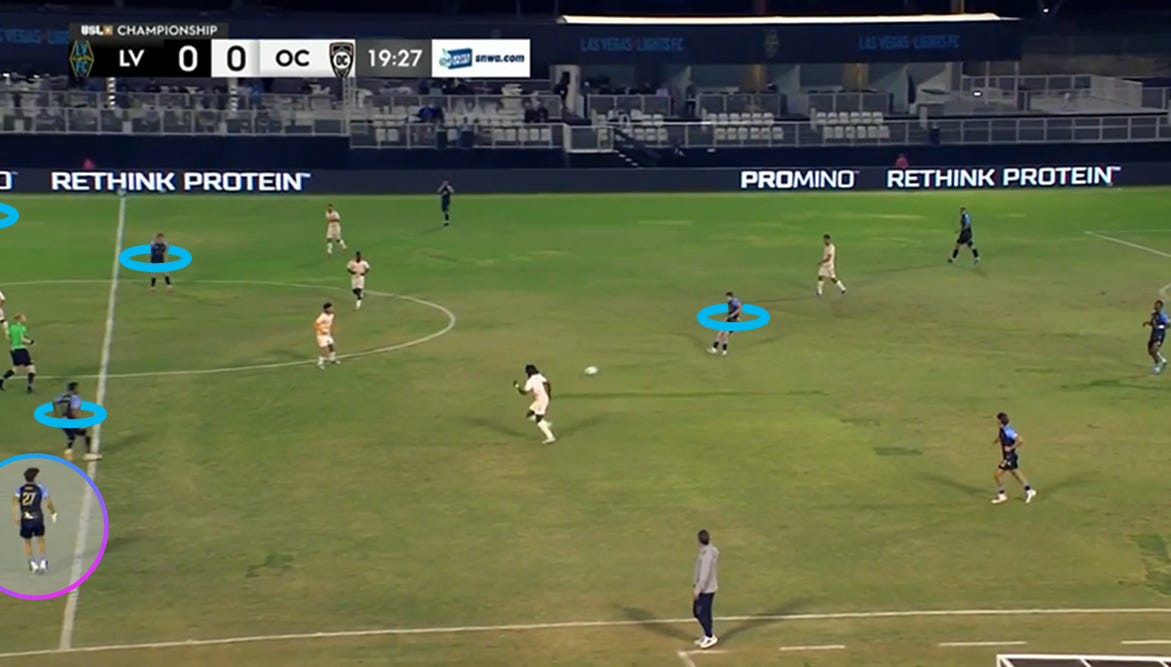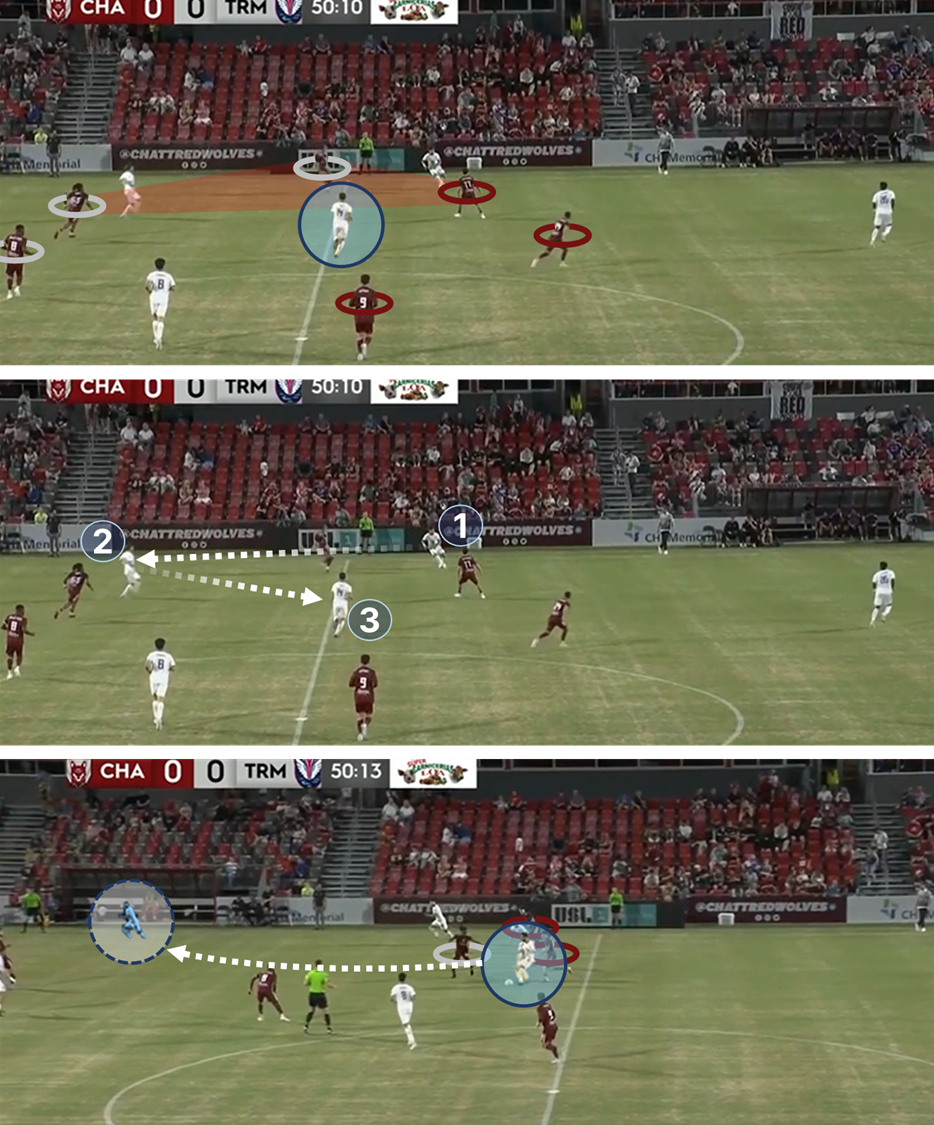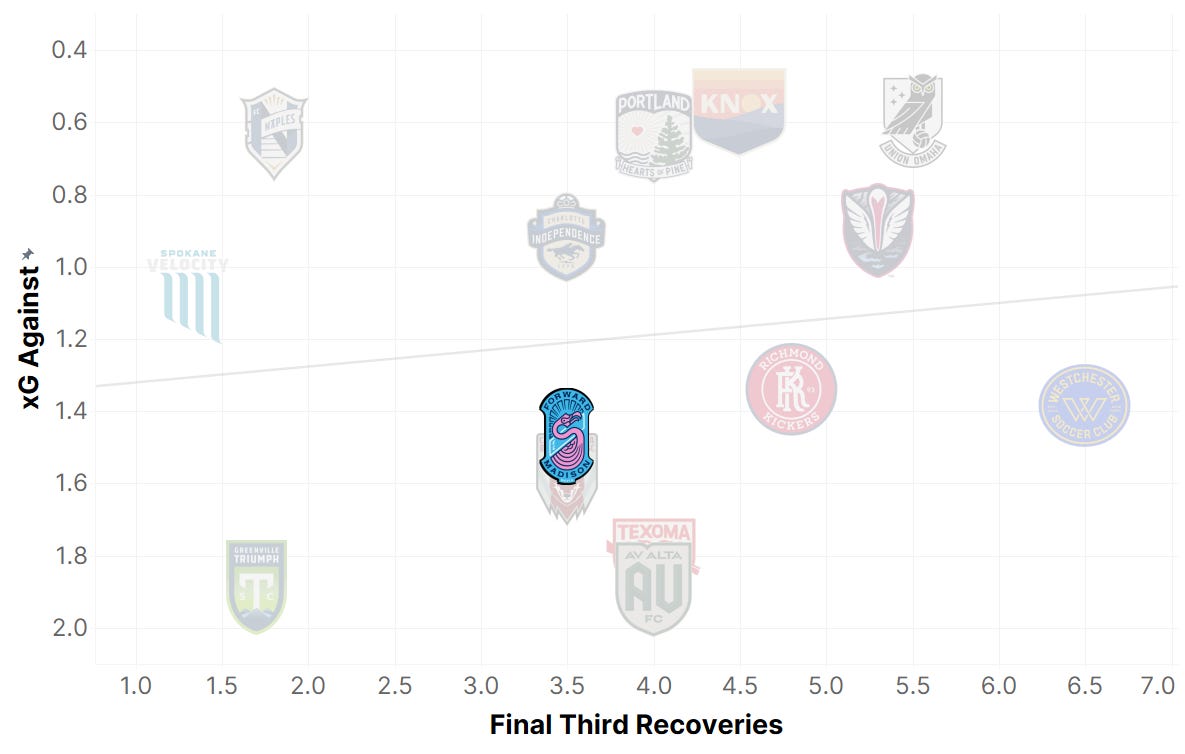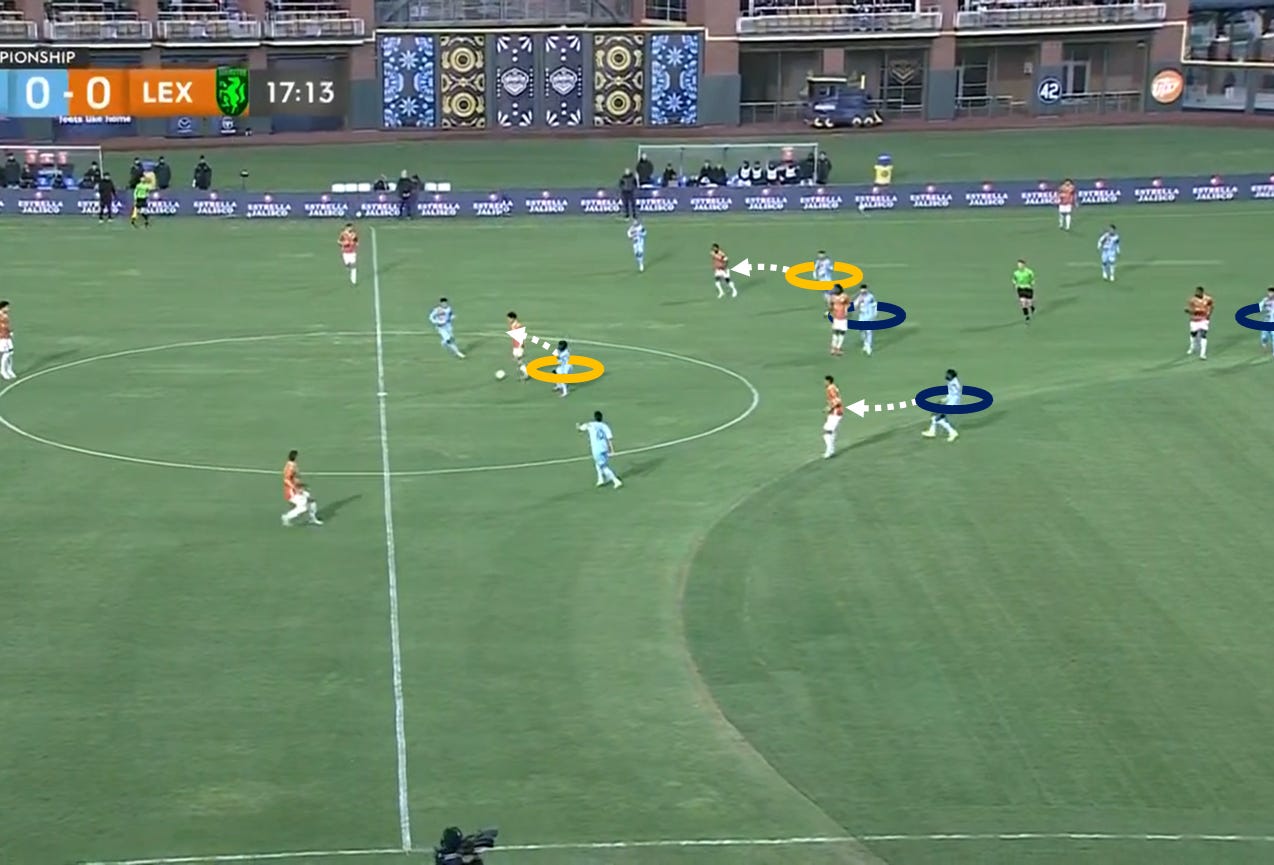The Back Four: Indy, Madison, and malleable midfields
Breaking down major stories from Week 5 in USL League One and the USL Championship
Welcome in to The Back Four!
Before we start, be sure to check out Backheeled for a massive deep-dive into all things USL Championship. From Sacramento’s stylistic evolution to Hartford’s struggles and everything in between, it’s all there. You can also find This League! there for an audio and visual dive into the week that was.
Without further ado, let’s get to it.
Enigmatic Eleven
Few teams have been as rip-roaringly fun as Indy at their best in 2025. Few have been as frustrating at their worst. Finding a happy medium between an increasingly imposing offense and an unreliable low-block defense is Sean McAuley’s challenge as the USL season hits its stride.
Seeing matches out in a defensive posture has been a recurring issue so far this year. Indy gave up a 93rd minute set piece goal against North Carolina on Saturday to spoil a generally strong performance, furthering what’s now a streak of three consecutive blown leads. As put on the always excellent The Game Beckons blog:
What exactly is going wrong without possession? For my taste, it’s a mix of meek front-line pressure out of the 4-4-2, a low-chemistry back line, and a good pivot that’s overmatched trying to make up the difference between those two problem areas.
Consider this sequence from the second half of the draw against North Carolina. Here, Indy holds their 4-4-2, but they’re ceding a mile of space between the lines. Meanwhile, forwards Jack Blake and Edward Kizza aren’t quite tight enough to prevent an opposing player from squeaking between them into said space.
By the second frame, that receiver – defender Conor Donovan – hasn’t been closed down, either by the pivot or an inside move from winger Oliver Bryneus. Blake is pursuing him from behind, but he’s not going to get there in time to make an impact.
In theory, this should be an easy situation; Donovan has three successful dribbles in his last 5,400 minutes in the USL! Instead, the center back is allowed to march upfield without a response and hit a teammate to keep North Carolina moving.
That sensation of allowing access in front of the back four is familiar by now. A week back, Anthony Fontana and substitute Marco Micaletto picked up 18 touches in the left halfspace, most notably en route to Colorado Springs’ first goal. Two weeks ago, Nick Firmino got 19 halfspace touches all his own because of the same fault in the 4-4-2.
In that shape, you’ve got one winger on the sideline and one member of the pivot next to him in a given half of the pitch. There aren’t layers to your coverage. In a 4-2-3-1, by comparison, it’s easier to create multiple barriers, denying progression step by step up and down the pitch.
Without those “steps” in the defensive shape and because too many Indy players are ball watching in this specific play, NCFC can slice into the channel and find another massive gap between lines. Here, left back Aedan Stanley steps to the presumptive receiver (highlighted in white) in the top frame above, but NCFC actually finds a different outlet between the lines.
Because Stanley has taken the bait, you end up with the situation in the second frame: North Carolina is on the ball in the final third, and they’ve got two options – forward Evan Conway and wingback Jaden Servania – covered by an overmatched Ben Ofeimu at right back.
Indy won’t concede here. James Murphy (circled in red) recovers splendidly to deny the cross-field pass, giving Maalique Foster just enough time to drop into the box and stall the guests out. Still, we’ve seen Indy concede these sorts of moves in big moments far too often.
That “big moments” condition is key: the Eleven are mostly dominant! Players like Stanley and Bryneus and Blake are operating at an all-league level at their best! Something changes when Indy gets a lead. For me, it’s a defensive shape issue. Despite playing a league-high five matches, the Eleven rank 23rd in the USL for midfield takeaways. In other words, Indy is very good about running the show when they possess, but they can’t get a stop when they need to sit off.
So is it time to panic in the Circle City? Not for my taste. There isn’t a question of talent, which Indy has in spades. The problems are correctible. More discipline and more game minutes should help the cause, and Sean McAuley has already made it clear that he expects improvement.
Bright Lights
Antonio Nocerino has been a thief of joy in the USL since taking over Miami last year, running teams defined by a dull and unsuccessful brand of football at their worst moments. That’s harsh, but it’s also true.
Still, Nocerino is a better manager than the low points indicate. He’s someone who carved out a truly stellar playing career rife with Italian national caps and appearances in both Serie A and the Premier League for a reason: he knows ball! This Saturday was the moment we started to see it in earnest in Las Vegas.
After rolling with a very deep 5-2-3 in March, Las Vegas dropped a defender and rolled with a 4-4-2 against Orange County over the weekend. On paper, the change wasn’t all that revolutionary. The Lights scored just once on 0.6ish xG. Valentin Noel took a mere 42 touches, his second-lowest return of the year. Still, Las Vegas’ threat was far more consistent, and Noel in particular was receiving the ball in far more dangerous spots than we’d yet seen under Nocerino.
When I say “4-4-2,” take that with a grain of salt. Beyond getting more players upfield on a more consistent basis, the refreshed shape also granted the Lights needed fluidity. In Noel’s particular case, that led to 13 touches in the left-attacking zone of the pitch and 16 touches in his own half. Some of the variety owed to a mid-game position change, but it’s emblematic of his cross-field, hard-to-pin-down sensibilities – and Las Vegas’ general vivacity.
Say the Frenchman sought a touch on the left sideline. Instantly, he’d be replaced by Christian Pinzon pushing ahead like a forward, thereby challenging the opposing defense to pick their poison. The Las Vegas midfield was defined by Patrick Leal and Rory O’Driscoll operating with a high-low split already, and any deep dive from Noel added another layer of intrigue in the center of the park.
In prior weeks, it wasn’t really clear who was playing quarterback in build, and the Lights often had to resort to aimless long balls to advance. That changed against Orange County, and left back Gennaro Nigro was clearly Las Vegas’ most reliable initiator.
Nigro, who’s seen possessing in a narrow-ish deployment in the halfspace above, took 100 touches. That’s 23 more than any other player on the pitch for either side. He ultimately completed a whopping 13 passes into the final third, went nine-for-14 on long balls, and assisted Nighte Pickering’s winner.
The creative gravity offered by Nigro forced OCSC to step up, thereby opening more space for midfield interchange. Above, that means Noel is an open receiver on the left, but it also allows Johnny Rodriguez to get involved. Though the star striker only has one goal and seven shots in 2025, defenses respect Rodriguez, even when he’s dropping in.
Put it all together, and you’ve got a play where (1) Nigro will hit Noel on the sideline in space as (2) Rodriguez drops to draw the defense and allow Pinzon and Joe Gyau to push behind. It’s fluid, fast-paced, and exactly what you want to see from this team.
Las Vegas hasn’t been efficient enough in the final third. They’re still learning how to play as a team. Still, Saturday was a big step forward for the Antonio Nocerino project, the kind of match that ought to be a blueprint for the Lights all season long.
Drey Day
I dug into Chattanooga’s 3-4-2-1 press last week, and while I don’t know if I’m bought into the Red Wolves’ whole schtick this year, I’m convinced they’re going to be extremely annoying to play against; there’s a reason they’re allowing 0.96 xG less per game this year.1 To that end, Alon Drey’s ability to withstand that pressure at the base of the Tormenta midfield was a real highlight this Saturday.
You can call South Georgia a 4-2-3-1 team and be correct in that statement, but they often want to push one of their center mids further upfield. Against Chattanooga, that player was Gabriel Cabral. The Brazilian midfielder took double-digit touches in the final third, while Drey took just three. That was by design, but it also put an extra burden on the Israeli international to stay tidy while facing down the Red Wolves’ press.
Drey did so with aplomb, posting an 84% passing accuracy overall and completing 33 passes within the defensive zone to lead all players in Saturday’s match. You see a prime example of how #14 did so above.
At the start of the play, Chattanooga is able to pin left back Gabriel Alves against the sideline with a winger/wingback trap. In classic Alves fashion, he plays a very difficult pass through the pressure into Cabral’s feet, but now Cabral is under pressure as a Red Wolves midfielder closes down.
Enter Drey. The moment Cabral is about to receive, Drey makes an ever-so-slight sideways hop into space toward his right. In doing so, he gives his pivot partner a better passing angle. When Drey receives, he’s instantly under pressure and knows that taking a controlling touch would be a risk. Rather than invite a turnover, he first-times a pass around a closing Chattanooga defender, breaks the press, and sends South Georgia advancing.
The technique there is workmanlike but impressive. Drey gets that ball out from under his feet very quickly and accurately when you consider how his body is moving!
It’s not an especially sexy sequence, and Tormenta won’t turn it into a chance. Still, the ability for a defensive mid like Alon Drey to constantly make intelligent one- or two-touch plays under pressure is vital to his team’s system. South Georgia has held 53% of possession on average this year, and they need a safe pair of hands to make it happen. Drey provides that surety and thus allows his teammates upfield to get more creative without as much of a burden in build.
Same idea here, but in a more progressive context. Tormenta starts with the ball at Oscar Jimenez’s feet at right back, and they advance upfield in three key stages:
Given the shape of the Chattanooga 3-4-3, specifically in terms of forward Joshua Ramos’ potential to intercept, a sideways pass into Drey is risky. As such, Aaron Walker shows low from the right wing to keep play moving.
Walker will receive from Jimenez knowing that he’s got midfielder Michael Knapp closing on his back. As such, Walker will swiftly first-time hit a pass into Drey’s feet in a quick 1-2-3 sequence.
With the defense scrambling to close down on the central action, Jimenez spots a lane on the outside. Drey, flashing incisive skill as a passer, will curl a through ball into the trajectory of Jimenez’s overlapping run to push Tormenta into the final third.
Once more, it’s quick-thinking display from #14 that takes advantage of the small spaces allowed by the Red Wolves.
I’m not here to tell you that Alon Drey is the best center mid in the league. I don’t even know if the best version of Tormenta – a team with a very strong stable of central options – features him in the starting lineup! What I am here to note is that he’s a very good decision-maker that can do a job under pressure, and that’s valuable. South Georgia hasn’t hit their stride quite yet, but figuring out which of their new signings can make a difference while still earning points is as good as you can hope for in early April.
Should we worry about Madison’s defense?
Spoiler alert: probably not. But maybe?
Forward Madison has earned their keep by being a defense-first team under Matt Glaeser, but they haven’t looked the part so far in 2025. Last year, this club allowed a stunningly stingy 1.04 xG per match across all competitions. That number has ballooned to 1.47 this year, albeit in a tiny sample size.
Things kicked off with a 2-0 loss to FC Naples in the season opener, but that match wasn’t all that concerning in a vacuum. Messy turnovers at the back led to the concessions, and while Naples put up 1.52 xG to exceed their season average by nearly 50%, Madison did well to maintain structure and limit chances as they dominated possession.
Two subsequent matches – a Henny Derby win over Richmond and Open Cup loss to Tulsa – have me feeling a bit less sure. Madison have seemingly upped the ante in terms of the aggressiveness of their pressing scheme, but their defensive chemistry has gone wanting across multiple lines.
Year over year, Glaeser’s side is winning the ball back in the final third 25% more often, though that only puts them in the dead middle of League One in 2025. Still, Madison’s average defensive action has come just 38 yards away from the endline, one of the lowest marks in the division.
The takeaway? It’s been feast or famine; when the press has come together, it’s done well, but there’ve been even more press breaks ending with Madison get pinned back into their own zone.
This team is still rolling with a familiar 3-4-3, so what’s making the difference? It’s instructive to think about the win over the Kickers, a match where the Wisconsinites held just 40% of possession and conceded 20 shots despite picking up three points.
The example here highlights why I’m just a bit shaky about Madison for now. The play develops in three stages:
Madison’s front three applies face-up pressure to the Richmond back line and forces the ball wide. Wingback Nico Brown steps up near winger Derek Gebhard to try and pin the Kickers against the sideline, but there’s a lane between the duo on the left side of the 3-4-3.
As the sideline trap fails, Richmond can hit a central midfielder in space. Brown starts to recover low, and midfielder Aiden Mesias steps up from the pivot, but their reactions won’t come in time to stop the guests from progressing.
Richmond finds winger Matt Bolduc in a one-on-one against defender Jake Crull, putting stress on the Madison back three.
While this sequence ultimately ends with goalkeeper Wallis Lapsley claiming Bolduc’s eventual cross, it’s representative of the moves Madison have allowed time and again in their last two matches. Any time one of your center backs is forced into a transitional one-on-one, that’s a bad omen.
Similar sequences doomed the League One side against Championship opposition midway through last week. Madison was quite competitive with FC Tulsa for long stretches in that Open Cup match, but a few transitional moments were the death knell.
Here, Tulsa is restarting from the back, facing down a Madison team in more of a 5-2-3 orientation. There isn’t a whole lot of pressure on the opposing goalkeeper: Juan Galindrez, here serving as the left winger, hedges his bets before closing down, and Tulsa has already picked out a pass by that moment.
The great distance between Devin Boyce on the right wing and Ferrety Sousa at right wingback allows the guests to double up against the deeper defender. Sousa is targeted, and Madison’s shape is too spread out to effectively support him.
A lot of that effect is driven by Tulsa’s expansive spacing, but it takes too long for the ‘Mingos to get compact even when the guests commit to a flank. When Sousa loses the header, there isn’t a coherent structure to pursue the second ball. Tulsa can claim the knockdown, push two runners past the ball-side wingback toward an overmatched Timmy Mehl (see the freeze frame), and score a decisive second goal at the end of it all.
Yes, this is a terrific bit of quick-twitch, direct soccer from FC Tulsa, but Madison’s reactions are consistently a step slow.
Still, consider the personnel discussed across the board here. Nico Brown is new to the Glaeser system; ditto for Lapsley. Mesias only started nine matches in the league across all of 2024. Ferrety Sousa is adjusting to a new deployment on the right. We haven’t seen the vaunted Mehl-Osmond-Crull center back trio play a single minute yet this season. Of course the chemistry is off – this team lost Jimmie Villalobos as their midfield anchor and is integrating a boatload of new talent!
Do things need to be sharper? Sure. Is it time to hit the panic button? Not yet. Forward Madison haven’t been at their defensive best by a longshot, but they’ve faced down a tough schedule, weathered major availability issues, and still have the blueprint to make it work.
Quick Hits
In other news this week…
Bigger section on Alta coming soon, but you love to see Eduardo Blancas and Harrison Robledo thriving. Antelope Valley sold out their home opener, and their first goal – driven by Robledo shrugging off basically the entire front end of the Westchester 4-4-2 before linking with Jimmie Villalobos in a wonderful inside-out break – was a lovely piece of team play. I was high on this squad in the offseason, and I’m amped to see it come together.
El Paso is winning the ball back just 2.4 times per match in the final third, but don’t let that number fool you: this team is aggressive. The Locomotive rank third in the USL with 99 midfield takeaways to date. They’re intercepting 11.0 passes per game, while the second-ranked team in the Championship is only at 8.3.
Take this screenshot from the win over Lexington. I’ve called out five players: the three center backs (in blue) and center mids (in yellow) to illustrate why this team is so fun.
So, uh, you might notice that the center backs are playing like midfielders? That’s by design. Palermo Ortiz and Wahab Ackwei were allowed to step up and mark Lexington’s dual No. 10s, and it did wonders in terms of denying a very good attacking team. Really innovative and bold stuff here from Wilmer Cabrera.
There was originally meant to be an Emilio Ycaza section here, but you can see Backheeled or this week’s USL Tactics Show for that. Suffice to say: great player! Seven defensive actions, seven recoveries, 87% passing accuracy, and absolutely fantastic off-ball movement in a big win against Tampa Bay this weekend.
Orange County have lost their momentum and then some, and I’ve focused a lot on teams marking Kyle Scott and Chris Hegardt within an inch of their lives in my Backheeled columns. The other big thing? A lack of pressing success. OCSC is winning the ball back in the final third 0.5 times per match this season, which is completely dismal.
I’m Lamine Jawneh pilled. Texoma might be bad, but he’s been great about finding touches, facilitating from side to side, and throwing in some No. 9 things.
I somehow just watched Apocalypse Now for the first time, and…uh…yeah, great movie! I kinda can’t stop thinking about it. Highly recommend Hearts of Darkness as a companion watch. That’s the documentary Eleanor Coppola shot about the shambolic production of the movie proper, and it’s a hoot.
This number is fucking shocking, if you aren’t aware. There are teams that allow 0.96 xG per game, period. For that to represent Chattanooga’s improvement is a major feather in Scott Mackenzie’s cap.









